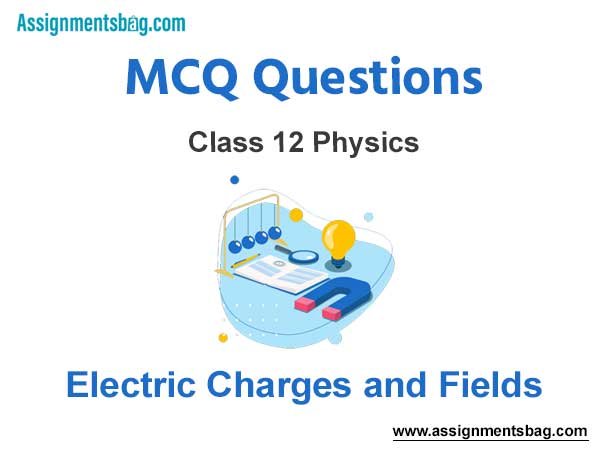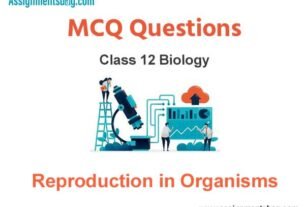Please refer to MCQ Questions Chapter 1 Electric Charges and Fields Class 12 Physics with answers provided below. These multiple-choice questions have been developed based on the latest NCERT book for class 12 Physics issued for the current academic year. We have provided MCQ Questions for Class 12 Physics for all chapters on our website. Students should learn the objective based questions for Chapter 1 Electric Charges and Fields in Class 12 Physics provided below to get more marks in exams.
Chapter 1 Electric Charges and Fields MCQ Questions
Please refer to the following Chapter 1 Electric Charges and Fields MCQ Questions Class 12 Physics with solutions for all important topics in the chapter.
MCQ Questions Answers for Chapter 1 Electric Charges and Fields Class 12 Physics
Question. The electrostatic force of repulsion between two positively charged ions carrying equal charge is 3. 7 x I0– 9 N, when they are separated by a distance of 5 A. How much electrons are missing from each ion?
(a) 10
(b) 8
(c) 2
(d) 1
Answer
C
Question. If the charge on the body in I nC, then how many electrons are present on the body?
(a) 1.6x 10- 19
(b) 6.25x 109
(c) 6.25x 1027
(d) 6.25x 1028
Answer
B
Question. Consider two concentric spherical metal shells of radii ‘r1 and r2 ( r2 > 1j ). If the outer shell has a charge q and the inner one is grounded, the charge on the inner shell is

Answer
C
Question. Two particles of charges q1 = + 8q and q2 = – 2q are placed, as shown. At what point away from q2 on the X-axis, can a proton be placed so that it is in equilibrium?

(a) x= 2L
(b) x = 2.5L
(c) x= 3.0L
(d) x= 3.2L
Answer
A
Question. A charge Q is divided into two charges q and Q – q. The value of q such that the force between them is maximum, is
(a) Q
(b) 3Q/4
(c) Q/2
(d) Q/3
Answer
C
Question. A conducting sphere of radius 5 cm has an unknown charge. The electric field at 10 cm from the centre of the sphere is 1.8 x 103 N / C and points radially inward. What is the net charge on the sphere?
(a) 1.8 nC
(b) 2 nC
(c) 1 nC
(d) 1.5 nC
Answer
B
Question. Two charges each equal to q, are kept at x = – a and x = a on the x-axis. A particle of mass m and charge q0 = q/2 is placed at the origin. If charge q0 is given a small displacement y ( y < < a) along the y – axis, the net force acting on the particle is propo1tional to
(a) y
(b) – y
(c) 1/Y
(d) – (1/Y)
Answer
A
Question. Two identical charged spheres suspended from a common point by two massless strings of length I are initially a distance d(d <</)apart because of their mutual repulsion. The charge begins to leak from both the spheres at a constant rate. As a result charges approach each other with a velocity v. Then, as a function of distance x between them
(a)vocx- 1
(b)vocx112
(c) vocx
(d) vocx-112
Answer
D
Question. Two positive charges of magnitude q are placed at the ends of a side 1 of a square of side 2a. Two negative charges of the same magnitude are kept at the other comers. Starting from rest, if a charge Q moves from the middle of side l to the centre of square, its kinetic energy at the centre of square is

Answer
A
Assertion-Reason Questions
In the following questions, a statement of Assertion (A) is followed by a statement of Reason (R). Choose the correct answer out of the following choices.
(a) Both A and R are true and R is the correct explanation of A.
(b) Both A and R are true but R is not the correct explanation of A.
(c) A is true but R is false.
(d) A is false and R is also false.
Question. Assertion (A): The charge given to a metallic sphere does not depend on whether it is hollow or solid.
Reason (R): Since the charge resides only on the surface of the conductor.
Answer
A
Question. Assertion (A): Coulomb force and gravitational force follow the same inverse-square law.
Reason (R): Both laws are same in all aspects.
Answer
C
Question. Assertion (A): When a body acquires negative charge, its mass decreases.
Reason (R): A body acquires positive charge when it gains electrons.
Answer
D
Question. Assertion (A): Electrostatic field lines start at positive charges and end at negative charges.
Reason (R): Field lines are continuous curves without any breaks and they form closed loop.
Answer
C
Question. Assertion (A): If a proton and an electron a replaced in the same uniform electric field, they experience different acceleration.
Reason (R): Electric force on a test charge is independent of its mass.
Answer
B
Question. Assertion (A): Electrons moves away from a region of lower potential to a region of higher potential.
Reason (R): An electron has a negative charge.
Answer
A
Question. Assertion (A): Surface charge density of an irregularly shaped conductor in non-uniform.
Reason (R): Surface density is defined as charge per unit area.
Answer
A
Question. Assertion (A): Units of electric dipole moment are Cm and units of torque are Nm.
Reason (R): Electric dipole moment and torque are give by p = q (2a) and τ = force × distance. respectively.
Answer
A
Question. Assertion (A): Total flux through a closed surface is zero if no charge is enclosed by the surface.
Reason (R): Gauss law is true for any closed surface, no matter what its shape or size is.
Answer
A
Question. Assertion (A): Charge is quantized because only integral number of electrons can be transferred.
Reason (R): There is no possibility of transfer of some fraction of electron.
Answer
B

We hope you liked the above provided MCQ Questions Chapter 1 Electric Charges and Fields Class 12 Physics with solutions. If you have any questions please ask us in the comments box below.
